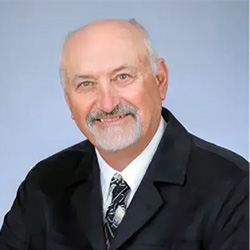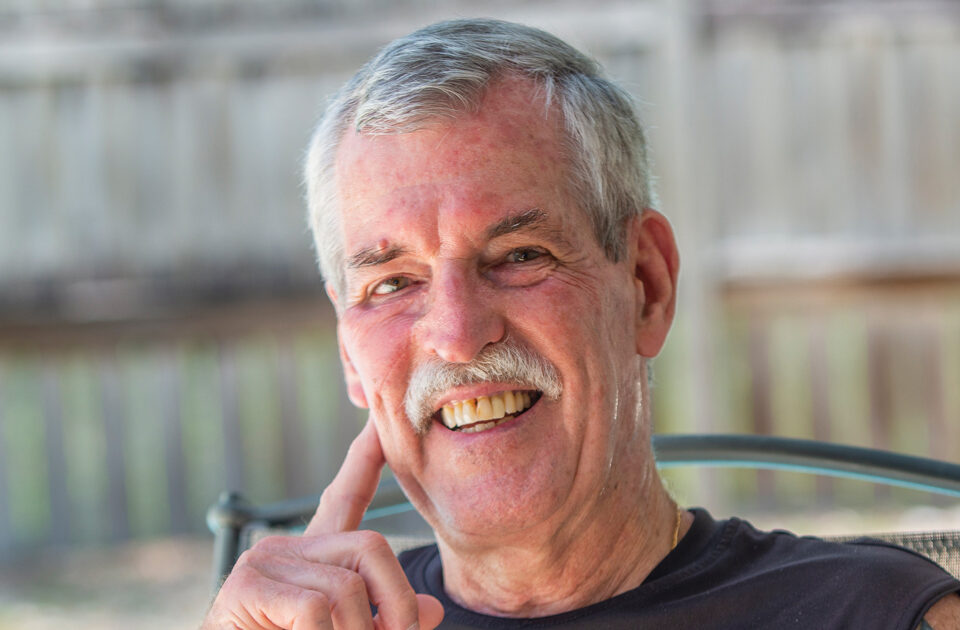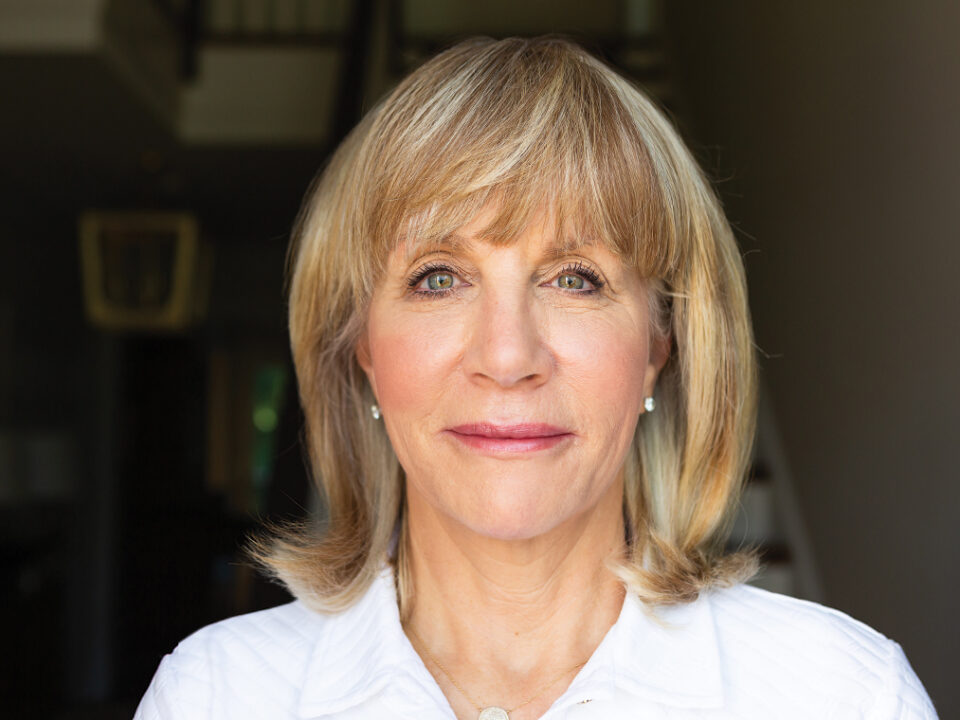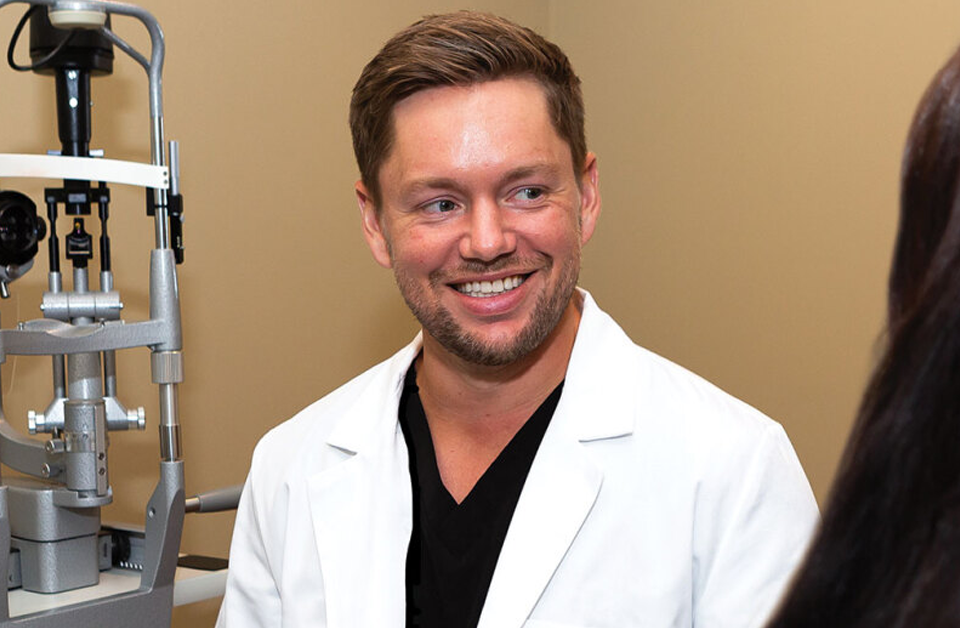

Jordan Pysz / ifoundmydoctor.com
The “miracle” of cataract surgery has given Katherine the visual clarity she desires. “Not only can I see clearly, but colors are brighter. Blues are bluer, and greens are greener,” she says.
While trying to decide where to live in retirement a few years ago, Katherine Easterly expressed a desire to reside on a Florida beach. At the same time, her husband, Coleman, expressed a desire to live in the Carolina mountains.
It took just two days around sun, sand and surf for Coleman to see things Katherine’s way.
“To help us decide, I signed us up for a two-month stay in a small town near Daytona Beach,” Katherine explains. “We were staying right on the ocean, and Coleman was working there, and after a conference call on our second day, he said, OK, I’m in.”
Coleman’s change of heart prompted the couple’s move from Virginia to Daytona Beach, where Katherine has decorated the couple’s new home with original artwork created while living in Charlottesville. Two pieces stand out.
“There’s a painting of some peonies in the entryway and one of the King Family Vineyards, near Charlottesville, where we used to go on Sundays to watch polo matches,” Katherine describes. “If you look closely at that one, you can see my husband and I and our dog in the background.”
Shortly after moving to Florida, however, the vivid colors in those paintings and everything else Katherine looked at began to fade. The issue, she soon learned, was the development of cataracts in her eyes.
Cataracts are the clouding of lenses that develop naturally from a breakdown of lens fibers, a clumping of proteins or both. As with Katherine, cataracts usually result in a reduction in the vibrancy of colors, blurred vision and an increase in the eye’s sensitivity to light.
“The first thing I noticed was that my vision was just getting worse,” Katherine recalls. “And then I noticed that the colors were fading a bit and that there was a lot of glare from lights at night. After all that, I went for an eye exam.
“That’s how I learned that I had cataracts, and at first, I just sort of sat on it. I didn’t do anything. I thought, I’ll just wait this out for a bit. Then a friend suggested that I go and see Dr. Vander Woude down in Vero Beach and have him check things out.”
Customize Your Vision
Logan T. Vander Woude, DO, MPH, is a board-certified ophthalmologist with the Center for Advanced Eye Care. During his initial evaluation of Katherine, he confirmed the presence of cataracts in both eyes and explained how they are treated.
Surgical removal of the cataracts is the only remedy, but the procedure is among the most common in health care. It is typically performed on one eye at a time, a week or two apart.
The surgery begins by numbing the eye with anesthetic drops. The physician then makes a tiny cut in front of the eye, uses a tool to break up the cataract and gently vacuums out the pieces. The removed lens is replaced with an artificial intraocular lens, or IOL, which is made of acrylic or silicone.
Standard IOLs correct primarily for distance, but patients can have one eye fixed for distance and the other for reading, an option called monovision.
Multifocal IOLs are a great option for patients desiring to get out of glasses. These lenses provide excellent vision for both distance and reading so that patients are much less dependent on any glasses.
A toric IOL reduces astigmatism, a condition that causes blurriness due to an irregularly shaped cornea, the transparent front of the eye.
Finally, light adjustable IOLs utilize breakthrough technology that allows custom vision correction. After we complete the surgery, the lens can be adjusted over the next several weeks using UV light to give you exact results and exceptional distance vision.
A decision on which lens is best is made during a consultation before surgery. Patients can express their vision wishes, and the physician explains the benefits of each IOL.
“Couldn’t Be Happier”
Dr. Vander Woude recommended a multifocal lens that would enhance distance and near vision and allow Katherine to be virtually glasses-free.
“This lens is designed to get you out of glasses most of the day, if not all day,” the doctor explains. “Katherine now has perfect 20/20 distance vision and the equivalent of 20/20 vision when reading.”
Katherine is ecstatic with the outcome. That’s common, according to Dr. Vander Woude, who says many patients receiving these IOLs are “wowed” by the results.”
“I couldn’t be happier,” Katherine exudes. “It’s a miracle, honestly, because I feel like I see differently now than I ever did. And I mean that in a good way. Not only can I see clearly, but colors are brighter. Blues are bluer, and greens are greener. It’s just fabulous.
“And I can’t say enough great things about Dr. Vander Woude and his staff. He did a great job of explaining all the pros and cons of the lens options that we discussed. The whole team is exceptional.
“You can tell that Dr. Vander Woude and everyone on his team really enjoys what they’re doing, and I would highly recommend them all. From start to finish, I was very well taken care of every step of the way, and I thank them for that.”
Good News About AMD
At one of the first true crossroads in life, Ellie Wade found herself torn between attending Bible school in Chicago or tending to her ailing mother in Florida. The Lord, Ellie says, chose her path.
“I prayed on it, and ever since then my shoes have been full of sand,” says Ellie, who made the move from Connecticut to Florida in 1965. “I eventually met the man who became my husband here, too, so it’s been a fantastic experience.”
Unfortunately, Ellie’s time in Florida also included helping her mother, who struggled with age-related macular degeneration, or AMD, an eye disorder that has become one of the leading causes of vision loss in people older than 50.
“My mother almost went blind from macular degeneration,” Ellie offers. “She had it so bad that when she talked with someone, she would listen to try to determine who it was but often had to say, I’m sorry, but you need to tell me who you are because I can’t see you very well.”
Because of her mother’s experience, Ellie has long been aware of the disease’s symptoms, which include blurred vision, dark or empty areas in the center of the visual field, and a muting of colors.
Another symptom is the illusion that straight lines appear wavy. Ellie first experienced that herself 13 years ago. When she did, she acted promptly and visited the Center for Advanced Eye Care, where she was treated by Adam M. Katz, MD.
Wet and Dry
Dr. Katz confirmed the presence of AMD, which affects the macula, the part of the retina that allows people to distinguish faces and see clearly while performing tasks such as reading and driving.
Dr. Katz explains that there are two forms of AMD: dry and wet.
Dry AMD is the most common, and it develops when the tissue of the macula thins and deteriorates with age. Also, small clumps of protein, or drusen, grow that can spark vision loss.
Wet AMD involves the growth of abnormal blood vessels under the retina. If these blood vessels leak, the blood and other fluids can damage the macula and lead to vision loss.
Dry AMD can progress into wet, but vision loss can be prevented through early diagnosis and intervention. However, early detection is difficult because symptoms are not always noticeable in the early stages.
Drusen can be detected early, however, so seeing an eye doctor regularly can help people avoid complications associated with wet AMD, which can be treated through injections of medication into the eye.
“I know the idea of an injection directly into the eye sounds terrible, but they are very well-tolerated by patients,” Dr. Katz assures. “That’s because we start by numbing the eye, and afterward most patients say to me, Is that it? Are you done?”
“What matters most, of course, is that these medical injections work. Before injectable medications, ophthalmologists tried treating patients with laser, a “cold” laser treatment called photodynamic therapy, or radiation or even surgery, but nothing worked.
“Patients didn’t go blind, but many lost the vision needed to read or drive because the best we could hope for was a stabilization of vision. In the past 10 years, though, things have changed dramatically, so there is now great hope for patients with AMD.”
The change is a result of the discovery of several medications that can effectively treat wet AMD. Those FDA-approved medications include bevacizumab (brand name AVASTIN®), ranibizumab (LUCENTIS®), aflibercept (EYLEA®) and faricimab-svoa (VABYSMO™).
Approved by the FDA in 2022, VABYSMO is the newest of these medications, and it’s growing in popularity among ophthalmologists because it is showing greater durability, which means patients can receive fewer injections.
“And there may be more treatments on the way,” Dr. Katz enthuses. “An injection for wet AMD that can be delivered through the sclera, which is the white part of the eye, instead of directly into the eye and has the potential to last six months or longer is now in clinical trials.
“Another option that may become available is gene therapy. This would be administered through a single injection that can create a biological factory in the eye that produces EYLEA for up to three years. This option is currently in Phase 2 clinical trials.
“And for the first time, we have an injectable medication that can treat dry macular degeneration. It’s called SYFOVRE™ (pegcetacoplan), and it received FDA approval just a couple of months ago.”
SYFOVRE is used to slow the progression of a severe form of dry AMD called geographic atrophy. Geographic atrophy is the last stage of dry AMD, but SYFOVRE can slow its progression by 20 percent over two to three years.
“This drug is certainly not a panacea,” Dr. Katz says of SYFOVRE. “But it is a welcome addition to our treatment options, and there’s another medication that’s in late-stage clinical trials, so the future is very bright.”
Worthy of Praise
Back when Ellie was diagnosed with wet AMD, treatment options were more limited. However, through injections of ELEYA every six weeks, her vision has improved markedly.
“When she first came to me in 2015 for treatment, her vision was 20/80 in both eyes,” Dr. Katz relates. “Now, it’s 20/40 in both eyes, so she can drive and see well enough to read and do most things that anyone without wet AMD can do.”
A former teacher who later became a design engineer, Ellie spends most of her free time “with the Lord” reading her Bible. She’s certain she wouldn’t be doing that were it not for Dr. Katz and the advances that have been made in treating wet AMD.
“If it weren’t for Dr. Katz and these treatments that they’ve come up with, I would have wound up like my mother was,” Ellie says. “So, I consider myself to be a very fortunate person. And I’m very fortunate indeed to have met Dr. Katz.
“He is an absolutely wonderful doctor, and so gentle. Just the thought of getting an injection into your eye is scary, but with the way he does it, it’s extremely easy and fast. It’s never a problem, so I would gladly recommend him to anybody and everybody.”

















